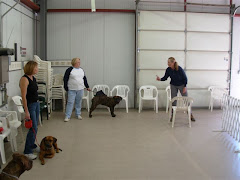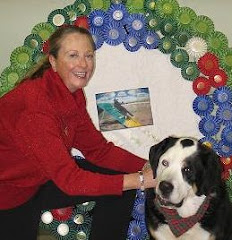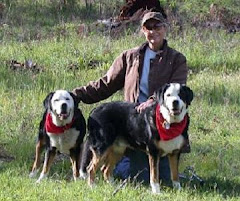

My friend Charlotte, another recent Montana transplant from Yakima, just adopted a five-year-old Australian Shepherd named Sammy, who'd been through Leadership Class years ago with his former owners.
Charlotte invited me for lunch last week and told me I could bring my pit bull Lizzie. We'd planned that Lizzie and Sammy could play together.
However, when Lizzie and I arrived at the door, Charlotte's new dog went into a barking frenzy before we even opened it. On the other side of the door, I could hear Charlotte 's nearly hysterical voice trying to quell the barking. When she finally opened the door for us, I saw she had her frenzied dog by the collar and was holding fast to keep him from lunging at Lizzie. She apologized profusely and said that she'd have to put Sammy in his crate in the spare bedroom while we were there.
"Yesterday a friend came over with her dog, and Sammy just laid into that other dog," she said. "He's become very territorial in the three weeks I've had him."
Based on my prior experience with Sammy, I was pretty sure he was not dog aggressive, and that Charlotte was misreading his actions. If anything, it sounded like a problem that needed to be resolved...and it couldn't be fixed by locking Sammy up in the spare bedroom. Besides, he was already barking his head off in his crate, so we could hardly hear ourselves talk.
"Charlotte, let's work on this," I suggested. "Bring Sammy back out here to the living room. Have him on a leash with his slip-collar. I'll have control of Lizzie. We'll help get them introduced the right way."
She was skeptical, but got Sammy out of lock-up and came walking down the hall toward us. Sammy was nervous, but Charlotte was even MORE nervous. Her entire posture showed fear and lack of confidence. As Sammy strained at the end of the leash, she struggled to hold him back. Sammy began his frenzied barking again, showing lots of teeth as he pulled toward Lizzie. Charlotte screamed, "Sammy! Sammy!" over the top of his barking. It was hard to tell who was more hysterical...Charlotte or her dog.
When Sammy was within five feet of Lizzie and me, I took one firm step toward him and said, with a loud, deep, strong voice, "HEY!"
Sammy shrank down, his ears went back, and he licked his nose. His eyes went soft and submissive. Although he showed nervousness with shifty glances from me to Lizzie to Charlotte, he controlled himself. The barking ceased.
I allowed my friendly Lizzie to go forward to diplomatically sniff Sammy. Charlotte sucked in her breath, expecting a dog fight. "Relax," I said. "Nothing's going to happen. This is just how they say hi. If you remain calm, your dog will calm down too. Let them sort it out. There will NOT be any fight here."
She was still not convinced. To her, Sammy had acted mean and viscious toward my dog and the one who had visited yesterday. In fact, when she first saw Sammy act up in front of yesterday's visitor, Charlotte had IMMEDIATELY REMOVED HIM from the situation, and stuck him in isolation. But not today.
"Let them greet without our interference," I said. "Neither of these dogs is aggressive. But when you try to physically restrain Sammy, and when you act nervous about the situation, that's his cue to act tough. If we just let Sammy and Lizzie be dogs as they meet each other, it'll all be fine in about 30 seconds. No fight."
Charlotte reluctantly dropped Sammy's drag leash, and I dropped Lizzie's leash. The two dogs began their ritualistic greeting with sniffing. Sammy tensed, and his lips curled, but he did nothing. As Lizzie continued to make friendly advances (swatting him, posturing to him, and rolling over to expose her belly), he started acting a bit braver. Within 30 seconds they were jaw wrestling and taking turns being "on top." Occasionally Sammy would still let out a high-pitched bark, but the snarling was gone.
"Sammy is not dog aggressive," I reassured her. "He will never start a fight with another dog."
And after his friendly, unrestrained encounter with Lizzie, he will be less likely to act like such a loud-mouthed bigshot the next time he encounters a strange dog.
While we ate lunch, we put our dogs in down-stays and watched them like mother hawks. Lizzie wanted to low-crawl over to Sammy (to play), so I corrected her for that. A couple times when Charlotte said something sweet to her dog, he bounced up from his down-stay and came over to her. She'd nicely correct him back to his down-stay spot. It didn't work well, though. Her correction was all too friendly and almost apologetic. She was afraid she'd hurt her dog's feelings by correcting him!
"May I help?" I asked, and she nodded. Next time Sammy got up, so did I. I walked to him, grabbed his drag leash, and quickly tugged him back down as I said (firmly) "Down! Staaaayyyy." No nicey-nices, no apologies, no petting. Those things could come LATER. First he had to do the job, a down-stay until he was released. And of course he did it, looking happy, relaxed and....employed.
It turned out to be a practical training session for Charlotte and Sammy. Charlotte learned that her dog's perceived "aggression" had been fueled by her own insecurities and trepidation, which she had telegraphed to her dog. Sammy had been acting tough because he thought that Charlotte was incapable of handling the situation. In the three weeks she'd had Sammy, she had smothered him with love and affection, while intermittently acting like a reactive disciplinarian. She had confused her dog by showing inconsistency in her leadership style.
Charlotte had to learn to relax and become a calm, assertive leader (thank you, Cesar Millan). Sammy had to learn to trust Charlotte in that role. It was as simple as that. As soon as Charlotte relaxed her emotional and physical grip on the dog, he would feel less pressure to act tough against territorial intruders. Trust had to become reciprocal.
If YOU have a dog who seems too bullyish to play with other dogs, you may be short-changing him. Get him in to a behavior expert like those at Manning Dog Training in Yakima, and get an assessment. It could be that a day or two of doggy day care (supervised play time with other dogs) will be the very best thing for him. Or it could be that "leadership training" is what YOU need to become the calm, assertive leader for your dog.


















No comments:
Post a Comment